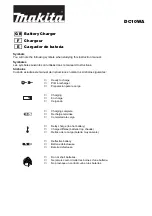
TROUBLESHOOTING
Display Indications/Common Problems/Possible Solutions
No Functions
• Check and make sure the charger is plugged into a live 110/120 volt AC outlet.
• Follow the steps outlined in the Operating Instructions section.
F01 — Internal Shorted Cell Battery
If the battery being charged has an internal shorted cell, the F01 will show. We
recommend taking your battery to a certified automotive service center for evaluation.
F02 — Bad Battery Connection or Battery Voltage Too Low to Accept
Charge
When F02 appears, the most common cause is poor connection to battery.
• Follow the steps outlined in “Important Safety Instructions” at the front of this manual
to disconnect AC cord and clamps, clean battery terminal and re-connect.
• If the situation persists, we recommend taking your battery to a certified automotive
service center for evaluation.
F03 — Sulfate or Unchargeable Battery
F03 appears when the battery is highly sulfated and cannot accept normal charge
current.
• Follow the steps in “Recondition Mode” to recondition the battery.
• Follow the steps in “Equalizing” to equalize the battery.
• If the situation persists after reconditioning and equalizing, we recommend taking
your battery to a certified automotive service center for evaluation.
F04 — Overtime Condition
F04 appears when charging time exceeds 18 hours.
You may be using a charge current rate too low for a large battery. Select higher
charge rate to charge the battery.
F05 — Overheated Condition
The ventilation grill that prevents the air from flowing in and out of the charger may
be blocked.
• Follow the steps outlined in “Important Safety Instructions” at the front of this manual
to disconnect AC cord and clamps, allow the unit to cool for 30 minutes and
reconnect.
• Make sure there is ample ventilation before resuming operation.
F06 — Reverse Polarity
The connections to the battery’s POSITIVE and NEGATIVE terminals are incorrect.
Follow the steps outlined in “Important Safety Instructions” at the front of this manual
to disconnect AC cord and clamps and re-connect to battery with correct polarity.
Charging a Very Cold Battery
If the battery to be charged is very cold (in temperatures below freezing — 0°C/
32°F), it cannot accept a high rate of charge. The initial charge rate will be low. The
charge rate will increase as the battery warms. Never attempt to charge a frozen
battery.
should it be charged at the 15 amp rate? See the chart above under “50%” and “at
15 amp rate.”
In most cases, battery charging times will vary depending on the size, age and
condition of the battery. Smaller batteries should be charged at a lower rate (2 amps)
and an extra hour added to charge time.
CARE AND MAINTENANCE
With proper care and minimal maintenance, the
2/10/15 Amp 12 Volt Smart
Battery Charger
will provide years of dependable service. For maximum
performance, manufacturer recommends:
• After each use, clean the battery charger clamps — be sure to remove any battery
fluid that will cause corrosion of the copper clamps.
• Clean the outside case of the charger with a soft cloth and, if necessary, mild soap
solution.
• Do not allow liquid to enter the charger. Do not operate when charger is wet.
• Keep the charger cords loosely coiled during storage to prevent damage to the
cords.
BLACK DECKER ACCESSORIES
GARAGE ACCESSORIES

























